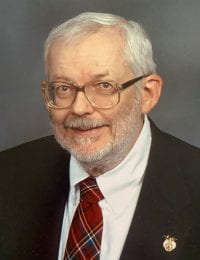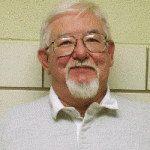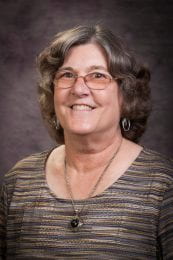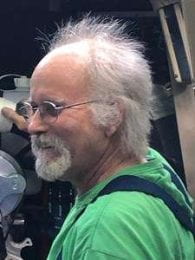Greetings from the Department Head
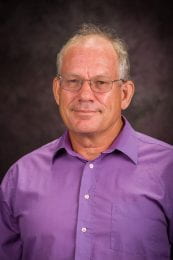
We hope you enjoy our reestablished annual newsletter. This has been a year of transitions, both happy and sad. Our beloved Peggy Matthews, office manager and so much more for 36 years in the department until her 2019 retirement, passed away unexpectedly this February. We have already begun work on a suitable permanent memorial for Peggy, who, in the words of Professor Brett DePaola, “ranks with A.B. Cardwell and James R. Macdonald in terms of importance to K-State Physics.”
Along with farewells come welcomes and bon voyages. New assistant professor Meng Han joined our faculty in the fall and is off to a great start in the Macdonald Lab while his young family settles in Manhattan. Long-time instructor John Pratt retired, and mainstay of JRML Kevin Carnes will do so in a couple of months. Finally, our “COVID generation” graduates this spring! Ten of the most resilient undergraduates in department history leave K-State this May with their degrees in physics to launch new chapters in lives around the world.
We still face many challenges. While our home College of Arts and Sciences has begun to recover from enrollment declines over the past decade, the financial situation remains tight; and we must continue to fight to maintain our identity as a world-class research facility that delivers excellent physics instruction from professional physicists to thousands of students each year. This is the best way that we can support K-State President Linton’s strategic vision of a NextGen land grant university. Our communications with stakeholders have improved dramatically with the development of new media across many formats. A major part of K-State NextGen is engagement with communities extending from campus into Manhattan and beyond to all of Kansas, the country, and the world. Engagement is nothing new for us. For example, we continue to honor requests from any Kansas K-12 school or community college to either visit them or facilitate a visit with us. We can get even better.
Our greatest asset continues to be you: the students, alumni, colleagues, and friends who support us. We want to hear from you. Please check out our website. Subscribe to our social media accounts that can be found on this page. Whether you received a physics degree here, advanced in your career, took one of our introductory courses, or trained up the physicist inside you at one of our public lectures, nothing will help us more than receiving your personal stories on how K-State Physics impacted you and the world around you. Please send us these stories. Call me at 785-532-1664. Send e-mail to me at tbolton.ksu.edu. If you are able, please continue to help us fund scholarships for our students and support initiatives in excellence, including a new award to honor Peggy Matthews as mentioned in the next article of this newsletter
Department Mourns Longtime Office Manager Peggy Matthews and Works to Honor Her Memory

Following the recent passing of longtime office manager, Peggy Matthews, department faculty are working to name a room after her in the department and to create a fund through the K-State Foundation to honor her legacy.
Matthews passed away suddenly on February 15, 2024, in Manhattan. She is survived by her husband of more than 50 years, Bill, and their two children Eric (Amy) Matthews and Staci (Mike) Burson and granddaughter Eliza Burson. Services were held at Yorgensen-Meloan-Londeen Funeral Home.
There are few that leave a legacy behind in a department at K-State as Peggy did. She began her career at K-State in the Office of Admissions and then was employed in the Division of Facilities. She joined the physics department in 1983 and was the driving force behind several department heads including Chander Bhalla, Jim Legg, Dean Zollman, Amit Chakrabarti, and Brett DePaola until her retirement in 2019.
Zollman, who worked alongside Peggy for 10 years during his tenure as head said, “Peggy had the ability to interact with and understand faculty, students, and even the university administration. Because of this, she was able to keep the Department running smoothly through several university, college, and departmental administrations. She also knew when to step back and smile at situations that on the surface seemed difficult. This sense of humor certainly helped me during my ten years as physics head.”
Matthews was oftentimes the first person that employees and visitors encountered when they came to the department. “With her special attention to collegiality and high quality support for all physics members, Peggy Matthews set the tone for the department that we have been so proud to be known for,” said Amit Chakrabarti.
Plans are underway to honor Peggy’s legacy in the department. An ad hoc committee has been formed and is currently working on plans to rename and dedicate the physics conference room in Cardwell 119 in honor of Matthews.
In addition, the department has set up fund at the K-State Foundation to fund a new annual award to honor a deserving employee who emulates Peggy’s extraordinary spirit while serving the department. Peggy was passionate about advocating for our department’s classified and unclassified professional staff who work to support the department and University. Her support of these valued members in our department was evidenced by the long-term employees remaining in the department staff that she hired and supervised over the years.
We invite and encourage past and present students, staff, and faculty who have benefitted from Peggy’s assistance over the years to please donate to the Peggy Matthews Memorial Fund (ksufoundation.org/give/PeggyMatthews). This will help ensure that our appreciation for Peggy’s 36 years of service to the department is never forgotten.
Building Interest in Science on Campus and Throughout Kansas
The department has been working to increase awareness of and participation in physics and STEM in general on campus and across the state this past year.
In addition to K-State Open House activities, our faculty, staff, and students have attended and hosted several events this year as we work to inform the next generation of scientists who will shape the future of Kansas and our world.
Faculty member Vinod Kumarappan and several of our graduate students participated in the Girls Research Our World (GROW) and EXCITE! workshops hosted by the K-State Advancement of Women in Science and Engineering and geared toward middle and high school girls. Vinod and graduate research assistants Claudia Morello and Parker Poulos led workshops where students performed hands-on experiments related to the greenhouse effect and investigated whether drinking straws work on the moon.

We hosted area high school students who toured physics and other science departments in the college in conjunction with our Peterson Public Lecture featuring Nobel Prize winner John Mather who spoke about the James Webb Space Telescope. In addition to touring the STEM departments, students had front row seats for Mather’s lecture, met with the college’s Associate Dean for Student Success, Melinda Cro, and had lunch with Dr. Mather where they were able to ask him questions about his career and the Nobel prize.
University distinguished professor Bharat Ratra gave several lectures at libraries and schools throughout the state on the expanding universe in addition to his open house lecture.
Physics undergraduates hit the road to show off some of our department’s best physics demonstrations. They attended Rocks & Rockets, a free event with fun and games for kids of all ages in Colby. This annual event is organized by Sara Lamm, sister of physics alumnus Hank, BS ‘11.
Undergraduate students and department head Tim Bolton participated in Clay County Schools summer STEAM program. Students (and teachers) engaged in hands-on activities built around rotations with torques and twists and a rotating bicycle wheel and stool. They also used super-long slinkies to learn about waves.
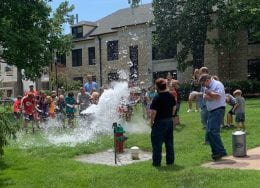
We hosted two local summer camp groups – Wonder Workshop and Cool Care Clubs – where we entertained kids with our most popular demonstrations including dropping a bottle of liquid nitrogen into a barrel of water on a hot July day. The nitrogen expanded in volume by a factor of 1000 as it boiled from liquid to gas, creating a big bubble that splashed water all over the kids with a big bang to their delight.
Stay tuned to our social media accounts so you don’t miss out on local K-State events if you’re in the area or find out if we’re coming to an event near you.
Degree Recipients
We are pleased to extend a warm welcome to the latest additions to our department alumni. The accomplishments of these 2023 degree recipients fill us with a sense of pride and we know that many more are forthcoming.
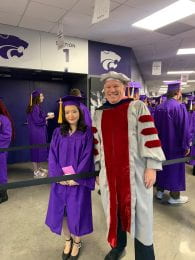
Bachelor of Arts & Bachelor of Science Degrees
Alexander Adamson – Bachelor of Science
Nolan Foth – Bachelor of Science
Dylan Parker – Bachelor of Science
Iori Sugita – Bachelor of Arts
Evan Swain – Bachelor of Science
Alexander Teeters – Bachelor of Science
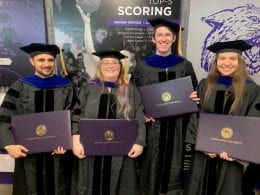
Masters & Doctoral Degrees
Shulei Cao, PhD, Advised by Bharat Ratra
Lindsay Morris, PhD, Advised by Brett DePaola & Brian Washburn
Shams El-Adawy, PhD, Advised by Eleanor Sayre
Christopher Hass, PhD, Advised by Eleanor Sayre
Katelynn Hubenig, MS, Advised by James T. Laverty
Shusil Sigdel, PhD, Advised by Christopher Sorensen
Amogh Sirnoorkar, PhD, Advised by James T. Laverty
Jo Lynn Tyner, MS, Advised by Glenn Horton-Smith
Dustin Ursrey, PhD, Advised by Brett Esry
Hanyu Zhang, PhD, Advised by Lado Samushia
Undergraduate Program Update
Our undergraduate program is seeing growth under the leadership of Amit Chakrabarti (director of physics major programs) and Janae Mooty (academic advisor) as we work to rebuild post-COVID. Janae was recently recognized with a College of Arts & Sciences William L. Stamey Undergraduate Advising award. The students are engaged in teaching, research, physics club, and outreach. The John P. Giese Undergraduate Center is filled with students studying, socializing, and other activities.
Our students have been the recipients of several honors this year. Dual major in physics and mechanical engineering Matthew Culbertson was awarded a Goldwater scholarship (see article in this newsletter). He was also featured in K-State’s flagship research magazine, Seek. Jeremy Kamman, dual major in physics and international studies, spent last summer researching computational materials physics in Germany with the support of the German Academic Exchange Service. He was also as admitted to Phi Beta Kappa in the fall. Caitlin Solis was awarded a College of Arts & Sciences research award in the fall. Noah McPherson, dual major in physics and chemical engineering was listed as Big XII Outstanding Freshmen at the 2023 Big 12 Conference on Black Student Government.
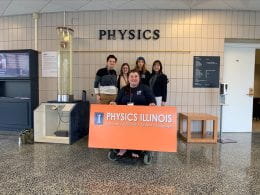
Several students attended the Conferences for Undergraduate Women in Physics (CUWiP) at the University of Illinois, Urbana Champaign in February of 2023. Naomi Downes said of her experience, “Looking around the room at all of the women in these CUWiP lectures was empowering on its own. Then adding all of the discussions and the realization that other people understand is a wakeup call. The thrill of the connection, empowerment, and learning about what physics can do for you and others is an experience you can’t get just anywhere.”
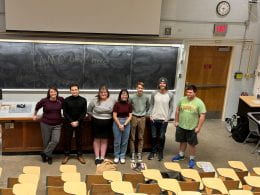
Our majors hosted their first undergraduate research colloquium in the fall. Students highlighted their research projects in oral presentations that focused on their experiences in summer research at K-State, REU programs, and internships. Their presentation skills and research were clear, concise, and impressive as they spoke to their fellow students, graduate students, postdoctoral research associates, faculty, and staff.
Our newest alumni from the undergraduate program have gone on to Thermo Fisher Scientific, Kubota Corporation, and KC Testing & Engineering, as well as to graduate programs at K-State and Missouri S&T.
Culbertson Named 84th Goldwater Scholar at K-State
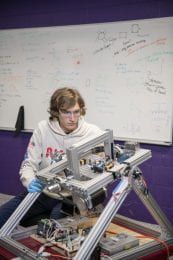
Matthew Culbertson, a senior studying physics and mechanical engineering, was named K-State’s latest Barry M. Goldwater scholar in 2023. He was among 413 natural science, engineering, and math students from across the United States awarded the prestigious merit-based scholarship out of more than 1200 nominees.
Matthew is working with research advisor Amir Bahadori in the radiological engineering analysis laboratory in the mechanical and nuclear engineering department. They are developing and testing a random position machine to simulate microgravity while conducting cell model irradiations. They hope to show how human cells react to irradiation in microgravity, in order to better understand what happens inside the human body in space.
Culbertson is the son of Anne and Chris (current K-State College of Arts & Sciences Dean) Culbertson. He graduated from Manhattan High School in 2020. Upon completion of his undergraduate education, he plans to pursue a PhD in Nuclear Engineering.
Introducing the Eisenhutts

Zach Eisenhutt and Sarah Kane were the best of friends at Liberty North High School in Missouri who made the journey to K-State together in 2019. Zach was looking for an affordable college education and after touring K-State, he knew he’d found the right fit for his educational pursuit and his budget. Sarah, a first generation student, had come to K-State for a campus visit with a friend looking at K-State’s Architecture program and had a great visit. She’d narrowed down her choices to Iowa State or K-State but ultimately decided to head to the Little Apple too.
Sarah always knew that she wanted to become a teacher. In high school, she found herself wondering how she would teach the lessons she was learning from her own teachers. She had seen many of her fellow students lose an interest in STEM when they transitioned to high school and thought that she’d like to inspire others to maintain the excitement they’d had in elementary school for these subjects. During her senior year of high school she participated in an educational internship program that paired her with an elementary teacher, and thus confirmed her career path would lead her to teaching secondary education.
Zach had been motivated by his high school physics teacher who taught class by asking students open-ended questions. He followed up with hands-on experiments to help them answer those questions, pulling a fluorescent tube out of the ceiling and then using it in several activities designed to demonstrate the concepts of physics behind it.
These experiences led Zach to pursue a dual degree in physics and math while Sarah chose to follow a path to Bachelor of Education and a Bachelor of Science in math. Along the way, she added a physics minor as she knew that underfunded schools often times have math teachers in their physics classrooms, plus the physics minor only required four additional classes.
During their freshman year at K-State, best friends Zach and Sarah took a leap into the dating world on February 29, 2020. When the COVID pandemic emerged a couple of weeks later and students were sent home and classes pivoted to remote learning they were grateful to have forged a new path in their relationship.
In fall 2020, most classes were still remote but the Physics Today class was taught in person while masked where the students and instructors of the course attempted to foster community that had been sorely missed. It was then that these students began to bond together, building relationships, working on homework together, and gaming on Zoom and in person.
The friendships they cultivated continued to bloom. When Zach and Sarah married on July 8, 2022, fellow physics majors Jeremy Kamman and Josh Barron were the best man and groomsman respectively. Josh’s girlfriend was Sarah’s maid of honor.
Sarah and Zach both credit Brandi Lohman as a major influence on them during their undergraduate career. They said that Brandi gave them an opportunity to teach General Physics and Engineering Physics labs. Brandi realized that Zach and Sarah had missed out on a lot during COVID 19 remote lab experiments. Thus, she assigned them to teach those courses so that they were able to revisit the labs they had missed out on as students. This benefited not only Zach and Sarah but the students they were teaching as well because they were able to better introduce these materials to them and could expand on the physics concepts driven by the experiments.
This spring, Sarah and Zach will be the only married couple we can think of in recent history at commencement along with their fellow cohort.
Zach has applied to graduate school and decided to remain at K-State to further his education. He participated in undergraduate research with Chapin professor Glenn Horton-Smith in high energy physics and is hoping to continue in this field. His research greatly benefitted him. He says, “I don’t think I could find a class at K-State to teach me what I’ve learned through the experience.” His project in which he does real time programming to connect directly with measurement devices that spit back data are part of an important piece of electronics that the K-State HEP group is building for an experiment that will ultimately reject backgrounds from cosmic rays. Zach says this research gave him valuable insight as to how much thought goes into designing an experiment of this magnitude on a huge collaboration and how the project he worked on was just a very small cog in a gigantic machine.
Sarah is doing her student teaching at Manhattan high school this spring. She is teaching college algebra and calculus AB. She knows that this career path is the right one for her as she is loving her time with the students and is looking forward to having her own classroom in the fall. Department staff know that they will be up to the career paths they have chosen. They have participated in several outreach activities for the department. Sarah was especially adept at leading a group of high school students visiting campus for the day in connection with Nobel laureate John Mather’s visit around the campus and both enjoyed demonstrating physics concepts at Rocks & Rockets, a STEM event in Colby, Kansas, organized by Sarah Lamm, sister of alumnus Hank Lamm.
Earning their degrees at K-State have not only brought this couple closer together but it has set them up for very bright futures that will influence future generations of learners.
Physics Club emerges from challenging post-pandemic period with renewed commitment
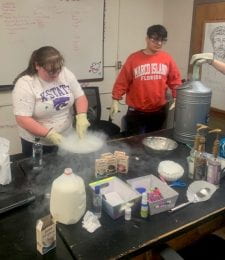
In March 2020, K-State began the transition from in-person classes to remote learning due to the COVID-19 pandemic. Education at K-State shifted to Zoom as students returned home and remained off campus.
Since the return to in-person classes the Physics Club has slowly returned after students had to rebuild connections with each other. However, thanks to active student leaders in the club, they have noticed a continual growth in membership and activities these past two years.
The group has students who are energetic and enthusiastic about the club and students, faculty, and the administration – are thrilled to see the club rebuilding. The club has been steadily ramping up their social activities and are active participants in department and university outreach activities.
“We’re excited to see the continued growth and enthusiasm in the Physics Club among our undergraduate students,” Tim Bolton, said.
The Physics Club has also revamped and revitalized the John Giese Student Undergraduate Room in the basement of Cardwell Hall. When passing through the basement of Cardwell, it is great to see the lounge in use by our majors and minors and filled with activity.
The pandemic may have altered the group’s trajectory but it is thrilling to see the return and reinvigoration of the Physics Club as they’ve resumed their activities.
Graduate Program Update
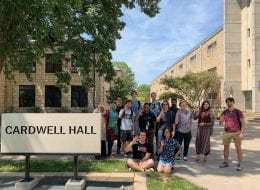
We started the 2023-24 year with an incoming group of 14 new graduate teaching and research assistants including a Fulbright Scholar. Half of them are from the United States, including two former REU students, and the rest from Bangladesh, Republic of Georgia, Germany, India, Indonesia, Korea, and Pakistan. Another student from India joined us this spring.
We have been working hard in partnership with our Physics Graduate Student Council and current students to improve new student orientation to better assist incoming graduate students. This year we added sessions on US financial literacy, conducted by a PowerCat Financial counselor, and on mental health, conducted by staff from Lafene Student Health Center.
Kurtis Borne who is working with JRM faculty Daniel Rolles had his research with Oxford University chemists studying ultrafast dynamics in a molecular photoswitch published in Nature Chemistry. Their experiment used ultrashort light pulses produced by the FERMI free-electron laser facility in Trieste, Italy, to track the conversion between the two isomers on a timescale of femtoseconds. The experimental results were interpreted with the help of state-of-the-art computer simulations done in Oxford. The combined study discovered faster than previously identified pathways leading to the conversion, which may help design new ways of controlling the outcome and efficiency of this important class of photoreactions.
Claudia Morello was awarded a College of Arts and Sciences Outstanding Graduate Student Award in March 2023. She is supervised by Matt Berg.
Lindsay Morris presented her research at the Capitol Research Summit in Topeka last spring. Her dissertation advisors were Brett DePaola and Brian Washburn.
Jennifer Tyler, who is mentored by Glenn Horton-Smith in High Energy Physics received an award from the Universities Research Association Visiting Scholars Program that will provide funding for her work on MicroBooNE at Fermi National Accelerator Laboratory.
Hanyu Zhang was a lead author on the publication “The DESI One-Percent Survey: Exploring the Halo Occupation Distribution of Luminous Red Galaxies and Quasi-Stellar Objects with Abacus Summit.”
Amogh Sirnoorkar published “Sensemaking and scientific modeling: Intertwined processes analyzed in the context of physics problem solving” in Physical Review Physics Education Research. Amogh was mentored by J.T. Laverty during his graduate studies in physics education research.
Our recent graduates have successfully found employment in academia and industry. This year’s students have secured postdoc positions at Boise State University, MIT, University of British Columbia, Purdue, and Waterloo Centre for Astrophysics. Others have gone on to the private sector in companies such as Exstratus, Jackson County Conservation District, and Hydrograph Inc, emeritus professor Sorensen’s startup company here in Manhattan.
Like Saturn’s moon Enceladus, PhD student Claudia Morello, is small but she’s made a big impact
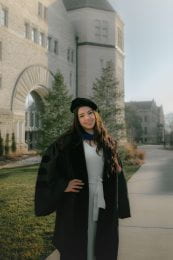
Claudia Morello dreamed of become a chef growing up in New Jersey. After participating in her school’s culinary program, she realized that cooking in a restaurant setting was not nearly as enjoyable as preparing food for her friends and family. She began to look to the stars when it came time to choose an undergraduate program and headed to Florida’s Embry-Riddle Aeronautical University’s astrophysics program because of her passion for astronomy, math. and physics – all courses in which she excelled.
In 2017, Morello came to K-State to participate in the department’s NSF-funded Research Experiences for Undergraduate program. It was then that she met her research mentor for the summer, Dr. Matt Berg, and began a project in which she developed an algorithm to simulate two-dimensional scattering patterns based on a particle’s silhouette. She enjoyed her summer in the program immensely and found the fresh air and small town vibe of the Flint Hills were not as bad as she’d originally anticipated.
Claudia returned to K-State to begin her graduate education in 2018. She continued her research under Professor Berg, this time on another project utilizing light scattering but to analyze cryovolcanoes on Enceladus, the sixth-largest moon of Saturn. The project combined her love of light scattering and astronomy.
Morello’s graduate path also led to increasing leadership roles in the department and student government. She served as the president of the Physics Graduate Student Council (PGSC) and advocated with her fellow officers and students to increase student stipends and change the format of the department’s preliminary written exams. Ultimately these endeavors were successful and will impact future generations of graduate students in the department.
Claudia submitted several proposals to the University’s Student Governing Association (SGA) to affect change for diversity within the department and provide additional graduate family support. Her proposals led to support for graduate student families and LGBTQIA2S+ physics graduate students, which are major accomplishments within the confines of SGA. For her efforts, Morello was named the College of Arts & Sciences graduate student recipient for outstanding leadership for her work with PGSC.
Claudia also worked to increase the participation, retention, and advancement of girls and women in STEM fields through several outreach projects with the K-State Office for the Advancement of Women in Science and Engineering program to include GROW (Girls Researching our World) and EXCITE. She designed and led workshops for these programs to increase female interest in the STEM fields.
Morello successfully defended her dissertation in February and will graduate officially this spring. She will return to the East coast to share her knowledge and expertise in the workforce. Claudia will apply her skills and experience in light scattering to our national defense.
There’s no doubt that Morello will continue to inspire others as she’s a natural born leader with many talents. She has always looked toward the sky to follow her dreams and she still puts her culinary abilities to good use as was evidenced by the tasty and beautiful cookies she baked for her thesis defense in the shapes of the sun, moon, and stars.

Dean Zollman Hosts K-SUPER Alumni Gathering
More than 30 current K-SUPER research group members and alumni met up at a luncheon hosted by group founder and mentor, Dean Zollman, to catch up and reconnect with each other. The luncheon was hosted in downtown Sacramento during the 2023 summer AAPT/PERC meeting.

The group of alumni, spanning more three decades of PER history, included former postdocs Raj Chaudhury (University of South Alabama) and Sanjay Rebello (Purdue University), lab director Rebecca Lindell (Tiliadal STEM Education), undergraduate major Ben Archibeque (postdoc at Oregon State University’s STEM Research Center), and graduate students Alicia Allbaugh (NASA’s JPL), Bijaya Aryal (University of Minnesota Rochester’s Center for Learning Innovation), Jackie Chini (University of Central Florida and moving to Ohio State University in the fall), Alicia Churukian (University of South Carolina), Edgar Corpuz (University of Texas Rio Grande Valley), Elizabeth Gire (Oregon State University), Kara Gray (Seattle Pacific University), Trà Huỳnh (Western Washington University), Morton Lundsgaard (University of Illinois at Urbana Champaign), Chris Nakamura (Saginaw Valley State University), and Xian Wu (University of Connecticut).

Rebecca Lindell expressed her appreciation to Dean Zollman for organizing and hosting the event and said, “It had been 20 years since we were all together. It was great to come back together!”
Zollman said. “It was enjoyable to have people from the early days of KSUPER get to know some of our recent and current students. We also heard from many KSUPER alumni who were unable to attend.”
The gathering allowed KSUPER alumni to meet the current research students and faculty, share updates on life and physics, and catch up with old friends. It felt more like a family reunion and it was wonderful to see all of these successful people in one room.
Alumni News & Honors
Kamal Bhandari (PhD ‘21) who is now a current postdoc at Clemson University and collaborators including his major professor Jeremy Schmit, published “Prediction of Antibody Viscosity from Dilute Solution Measurements,” based on Kamal’s PhD research in Antibodies.

Saima Farooq (PhD ‘16) was honored with the University of Maine’s College of Liberal Arts and Sciences Outstanding Lecturer award for 2023 last spring. Farooq is a lecturer in the Department of Physics and Astronomy. Saima received her PhD under the advisement of high energy physicist and current department head, Tim Bolton.
Praful Gagrani (MS ’18) completed his PhD at University of Wisconsin-Madison in 2023. He is now a postdoc at University of Wisconsin-Madison in the Origins of Life group at the Wisconsin Institute for Discovery. Gagrani is primarily interested in applying mathematical physics towards building techniques for understanding various aspects of complex systems. Praful worked under the direction cosmology faculty member Lado Samushia when he was a student at K-State.
Trà Huýnh (PhD ‘20) joined the faculty of Western Washington University in December 2022 as an assistant professor of Physics Education Research following a postdoc at University of Washington Bothell. Her research interest centers on equity and justice in physics and physics education. Huýnh was supervised by Professor Eleanor Sayre during her PhD.
Dissertation research carried out at K-State by Narayan Khadka (PhD ‘22) under the guidance of major professor Bharat Ratra led to a publication in The Astrophysical Journal. Khadka’s research developed into a collaboration that discovered how dust in galaxies affects some measurements of their distances and thus resolves a controversy.

Hank Lamm (BS in Physics and Mechanical Engineering ‘11) who is currently an associate scientist at Fermi National Accelerator Laboratory returned to campus to present a colloquium in the fall titled “Look What You Made Me Do: How Particle Physics Demands Quantum Computers” Lamm talked about the fundamental computational obstacles that quantum computers avoid, how future large-scale quantum computers are necessary to push the limits of theoretical high energy physics, and how the interim period is forcing physicists to reconsider previous notions of how quantum field theory is formulated.
Aleena Rafique (PhD ’18) was one of five early career researchers receiving a 2023 PSE U.S. Department of Energy Argonne National Laboratory Early Investigator Named Award. The award will support her project “Enabling precise measurement of neutrino interactions using advanced computing in the Deep Underground Neutrino Experiment (DUNE). The program was designed to support exceptional early career researchers at Argonne as they break into their fields.
“Graphene Nanosheets from the Controlled Explosion of Aromatic Hydrocarbons” was published in Carbon Trends by Shusil Sigdel (PhD ’23). Shusil was supervised by emeritus distinguished professor Chris Sorensen and mentored by research associate professor Arjun Nepal. Sigdel is an Application Scientist at HydroGraph Clean Power.
Jacqueline Spears (MS ’72) retired in May of 2023 after serving more than 30 years at K-State. Spears was a faculty member in the College of Education and a former dean at K-State Olathe. She had many achievements during the span of her career.
Nandana Weliweriya received the Sandy Beaver Excellence in Teaching award from the Franklin College of Arts & Sciences at University of Georgia. Nandana earned his MS in 2015 and PhD in in 2019 in Physics Education.
Undergraduate Alumni Spotlight – Sara Crandall (BS ’12 and MS ‘16)
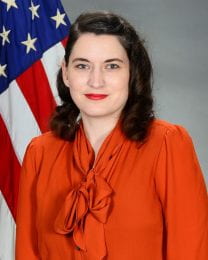
Sara Crandall may have come to K-State from the small town of Cheney, Kansas, with a population of ~2,000 people but this small town girl had big dreams that impacted countless individuals along the way. We all can be inspired and learn from Sara’s dedication to service throughout her life as she pursued both her BS and MS degrees at K-State and a PhD at University of California Santa Cruz (UCSC).
As an undergraduate physics major, Crandall was an active member of our Physics Club where she frequently participated in hands-on science demonstrations as part of the club’s outreach activities. She was a lab instructor in our undergraduate courses whose teaching philosophy inspired students to focus on their critical thinking skills by communicating their problem solving processes. A correct answer was not good enough, and true learning came in the journey through the problem. Her office hours were full of students who benefited from her commitment to their learning.
Upon completion of her BS in 2012, Sara continued her educational journey at K-State in pursuit of an MS degree. She worked as a graduate teaching assistant in the department while conducting research in the area of cosmology under the direction of now University Distinguished Professor Bharat Ratra.
During graduate school at K-State Crandall participated in a National Science Foundation sponsored program for a year, during which time she created and facilitated interactive physics modules for Junction City High School students. She utilized her own physics research to create modules that introduced students to real, hands-on science based on general and special relativity.
After graduating with her MS from K-State in 2016, Sara pursued a PhD in astrophysics from UCSC. In addition to her research she continued her science outreach by designing the completion of astrophysics projects for two high school students which resulted in a scientific publication.
During her time at UCSC, Crandall was highly focused on the support of students who were also parents as she had become a single parent during her graduate studies at K-State. She participated in a new student housing project on campus working with the USCS administration to inform them of how the high cost of living and low housing availability impacted students with families and the specific need for the university to provide a safe environment for their students with children while they worked to achieve their educational goals. She also volunteered in a working group on childcare that researched and documented the needs of university families which is still being utilized at UCSC. In addition, she designed and deployed the Students as Parents UCSC website, synthesizing information about accessing financial aid, housing, and childcare which provides links to resources about health insurance for dependents, ways to address food insecurity, and more.
Not only was she active in the aforementioned service projects in California but she also participated in the Santa Cruz’s Project for Inmate Education (PIE) program where she instructed jail inmates in algebra and astronomy courses as they worked to achieve college credit and gain confidence in their abilities and thought processes.
Upon completion of her PhD, Sara took the skills she acquired as a researcher in astrophysics and her dedication to service to the US Air Force where she serves as an operations research analyst supporting programmatic decision making on cost, risk, and schedule. She maintains a strong interest in US national defense strategy through science and technology development, small business innovation research, and digital transformation while ensuring that the needs of the nation’s warfighters are met.
Crandall’s journey serves as an example that can educate and inspire us all to embrace our own personal growth. We all have the ability to touch countless lives and foster a sense of service, compassion, and empowerment to better humankind.
Graduate Alumni Spotlight: Pablo Guimerá Coll (MS ‘15)
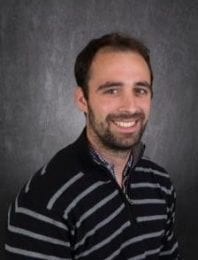
When Pablo Guimerá Coll (MS ‘15) arrived in Manhattan from the Canary Islands, beginning a company was the further thing from his mind. But that’s exactly what this K-State alum has done as co-founder and now R&D director of Crystal Sonic, a fast growing Arizona-based startup company that developed a semiconductor processing technology to improve yield and drive down the cost of advanced semiconductor substrate materials for use spanning the micro-electronics industry.
Pablo began his career at K-State as an undergraduate student taking courses while simultaneously completing a Bachelor’s degree in Physics at Complutense University in Madrid, Spain. His new life in Manhattan was not easy. In addition to taking undergraduate courses, he was working and traveling with the K-State women’s basketball team. During this time he encountered University Distinguished Professor Chris Sorensen and sought some guidance from him. Chris recognized that Pablo’s positive attitude and strong work ethic were getting him through a rocky academic start and began to mentor him.
Guimerá Coll joined the department’s graduate program as a GTA in 2011 where he proved to be an outstanding teacher. K-State students quickly learned that he had an innate ability to explain physics concepts very well and that he had an engaging personality that made him very approachable. This teaching earned Pablo two teaching awards – the department’s “Outstanding Teaching by a First of Second Year Graduate Student” award and the “Graduate Student Council’s Award for Graduate Student Teaching Excellence “in 2014.
Pablo began working with Sorensen as a GRA on a project involving the synthesis of nanoparticles where he discovered some remarkable solvation properties and shape evolution of gold nanorods under a process known as digestive ripening. This research and its results were the basis of his MS thesis which he completed in 2015.
Following his MS, Guimerá Coll began his studies in materials science at Arizona State University (ASU), which also has a great reputation in the field of solar energy research, which was Pablo’s lifetime passion. He excelled at ASU under the guidance of his PhD advisor, Professor Mariana Bertoni. Their research group discovered a way to cut semiconductor wafer materials like silicon with sound waves, a method that is 10 times faster than the conventional sawing process used in industry. This method reduced defects in the cut wafer and was much cheaper than current processes in use.
The discovery resulted in the award of a patent which led to the co-founding of Crystal Sonic with Bertoni and set the stage for Pablo’s current success. He won the National Science Foundation Engineering Research Center’s “Perfect Pitch” contest in Washington, DC, which included a $5,000 prize and the Lynn Preston trophy for his talk on “Sound Assisted Low Temperature Wafering for Solar Energy.”
In delivering a TED-like talk, Pablo gave his greatest piece of advice to the audience that we can all learn from – “Don’t let anybody, including yourself, deny you from achieving your dream.” Pablo is the twenty-first century version of the American dream – a dream that he not only followed but brought to fruition.
A Return to Physics—Catching up with Mansoora Shamim
Mansoora Shamim (PhD, 2008) completed her thesis on a search for evidence of the last possible space-time symmetry or nature, called supersymmetry, with high energy physicist Tim Bolton using data collected by the D0 experiment operating at the Fermilab Tevatron proton-antiproton collider. After leaving K-State she had a very successful six year run a postdoc at the University of Oregon where she worked on the ATLAS experiment at the CERN Large Hadron Collider in Geneva, Switzerland.
In 2013 Shamim and her husband Atta Ul Aleen Bhatti, a surgeon, returned to their home country of Pakistan to be near their family as they began their own, which now includes three children – son Hazeem and daughters Shaista and Tahreem.
In fall of 2022 Mansoora applied for and was awarded a CERN Post-Career Break Fellowship. This program launched by CERN offers full- or part-time fellowships to science and engineering graduates looking for a way back into science. It provides an outstanding opportunity for individuals to update their knowledge and skills while working for up to three years in an international environment at the forefront of research and opens up doors to longer term positions.
Shamim is enjoying her return to physics and has rejoined the ATLAS experiment working with colleagues she knew from her first stint there and new collaborators. She also works on FASER, an experiment exploring very high energy scattering phenomena that occurs at extremely small angle scattering at the Large Hadron Collider. She reports that “all the C++ and Linux is coming back”.
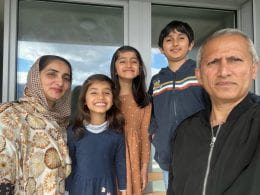
Mansoora’s children are adding French to their already impressive set of languages and her spouse is pursuing opportunities to practice surgery in Switzerland.
This is a fantastic diversity and inclusion program that CERN is offering to welcome scientists like Mansoora back to the workforce. And it’s great to have another K-Stater making an impact in the field of high energy physics.
Faculty News & Honors
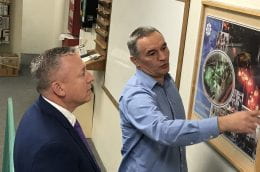
The J.R. Macdonald Lab faculty and staff were thrilled to host K-State President Richard Linton last spring for a tour of their facilities. Linton learned about the exciting AMO physics research happening beneath Cardwell Hall being carried out by our faculty, staff, graduate, and undergraduate students with funding by the US Department of Energy, National Science Foundation, Office of Naval Research, Air Force Research Laboratory, and the Research Corporation for Science Advancement.
Matthew Berg was promoted to professor. He is also Associate Editor for the Journal of Quantitative Spectroscopy and Radiative Transfer. Berg joined the faculty at K-State after serving as an assistant professor at Mississippi State University. He received his Ph.D. in physics at K-State in 2008 under major professor Chris Sorensen.
Glenn Horton-Smith and the high energy physics group hosted a successful MicroBooNE collaboration meeting on campus in October with more than 75 collaborators coming to Manhattan or attending on Zoom. The MicroBooNE collaboration investigates low energy excess events observed by the MiniBooNE experiment, measures a suite of low energy neutrino cross sections, and investigates astroparticle physics.

Vinod Kumarappan, a member of the JRM Lab faculty, was promoted to professor. The focus of his research is to develop methods to align and orient small molecules in the gas phase and to study ultrafast physics in the molecular frame. Vinod frequently contributes to our department’s outreach with the Kansas Associate for Women in Science & Engineering, leading workshops for their programs promoted women in STEM.
Distinguished Professor Chii-Dong Lin and collaborators proposed a high harmonic spectroscopy method for measuring the charge migration speed in a carbon-chain molecule, butadiyne that was featured in SPIE, the international society for optics and photonics.
Arjun Nepal was promoted to research associate professor. Arjun manages the K-State Physics partnership with Hydrograph Clean Power Inc. on graphene-related research, development, and production. He has also served as an NSF REU mentor and is currently one of the first research mentors in a new K-State program for students from USD 383’s Manhattan High School.
Bharat Ratra was named a fellow of the American Astronomical Society in 2023 for his pioneering research in cosmology and particle astrophysics leading to the development of dynamical dark energy models and for sustained commitments to science education, undergraduate research, and science popularization at all levels.
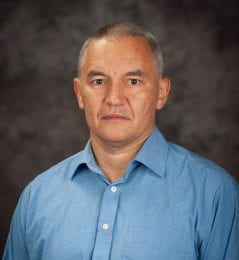
Professor and James R. Macdonald lab director Artem Rudenko was named a 2023 fellow of the American Physical Society for his “outstanding contributions to the understanding of correlated few-particle dynamics in strong field interactions with atoms and molecules, and for leadership in developing and conducting coincident molecular imaging experiments at X-ray free-electron laser facilities.”
Chris Sorensen, emeritus distinguished professor, published his long awaited book “Light Scattering and Absorption by Particles: The Q-Space approach” with IOP Publishing. The book provides an overview of how particles of any size or shape scatter and absorb light.
Daniel Rolles and co-PIs Loren Greenman and Artem Rudenko in physics, Nathan Albin and Dinh-Liem Nguyen in math, Christine Aikens in chemistry and Doina Caragea and Bill Hsu in computer science were recipients of a 2024 K-State GRIPex: AI in the Disciplines award. They plan to use artificial intelligence and machine learning to create molecular facial recognition software to identify actors in molecular movies by analyzing and interpreting experimental data from femtosecond and attosecond laser experiments performed in the JRML and connecting their findings with theoretical predictions from quantum chemistry. They will then use AI-based molecular image analysis to identify short-lived molecular structures created in ultrafast laser experiments, leveraging the unique experimental capabilities in ultrafast laser science by combining them with AI/ML expertise in computer science and math and with theoretical quantum chemistry expertise in chemistry and physics. This research will open exciting new research opportunities at the borderline between AMO physics and physical chemistry with potential applications in solar energy harvesting and storage, catalysis, biomedical molecular switches, and a host of other applications in chemistry and materials science.

Cosmologist Lado Samushia’s contributions to US Department of Energy research on dark energy and universe expansion led to the collaboration’s release of its first batch of data — with nearly two million objects for researchers to explore — and published their first set of papers related to the early data release. The papers include early measurements of galaxy clustering, studies of rare objects, and descriptions of the instrument and survey operations. Samushia also appeared on an episode of “The Space Between” podcast where he discussed dark matter, dark energy, and his current research projects in cosmology.
Listen to an interview with emeritus distinguished professor Dean Zollman conducted as part of the American Institute of Physics Oral History Project. The transcript of the interview covers Zollman’s experiences in physics beginning in graduate school in the 1960s while pursuing a PhD in nuclear physics through his nearly 50 year career as a faculty member who ended up as a pioneer in the field of physics education.
Department Welcomes New Faculty Member
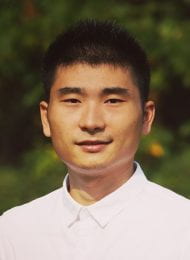
The latest addition to the faculty, assistant professor Meng Han, joined the department in the fall of 2023. Han received his PhD in physics at Peking University in 2020 under the direction of Prof. Yunquan Liu. As a graduate student, he studied phase problems in atomic ionization by strong laser fields.
Upon completion of his PhD, Meng joined the lab of Hans Jakob Wörner at ETH Zürich (where Albert Einstein once worked!) as a postdoctoral associate. His postdoctoral work focused on the study of the structure and dynamics of matter in the entire range from isolated atoms, molecules, and clusters to nanostructures, macromolecules, biomolecules, and macroscopic systems in the gas phase, liquids, and solids. Han was named a Marie Sklodowska-Curie Fellow in 2021 while at ETH Zürich.
At K-State Meng’s research in the James R. Macdonald Lab will focus on the generation, characterization, and applications of attosecond light pulses, particularly in circular polarization, which has unique advantages in real-time resolving of electron dynamics in chiral molecules and magnetic materials. (See the article Nobel Prize Connections below in this newsletter.)
Meng and his wife Yuanyuan Shi are enjoying the transition to their new life in Manhattan and being a part of the K-State physics family. They are parents of one-year old son, Che Han. They enjoy hiking, skiing, and cooking in their spare time.
Keep up with the latest on Meng’s research group and projects on his personal webpage.
Rolles sabbatical truly golden
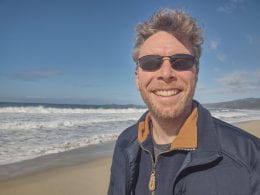
Daniel Rolles spent a productive sabbatical year in the golden state of California working with collaborators at Stanford’s PULSE Institute and SLAC National Accelerator Laboratory deepening his collaborations with colleagues at SLAC, PULSE, and the Linac Coherent Light Source (LCLS).
Rolles was joined on sabbatical by his spouse, Dr. Krista Danielson, faculty member in K-State’s English department, and their daughter. This was a return home of sorts as Krista grew up in California and met Daniel when he was a Fulbright scholar at SLAC. Thus, their family looked forward to returning to the area where it all began after several years.
Experiments at LCLS, the world’s first X-ray free-electron laser, are a key element of Rolles’ NSF- and DOE-funded research activities here at K-State. Thus, strengthening his ties was extremely beneficial for his research productivity and it also increases JRM’s competitiveness in obtaining federal funding since experiments at LCLS are a top priority for the DOE program that funds the J.R. Macdonald Lab.
When planning his sabbatical, its timing was aligned to the planned commissioning of a new instrument at LCLS. Unforeseen delays caused this to actually occur after Daniel’s return to Manhattan. Nonetheless, important preparations and planning happened during his stay and his on-site presence was beneficial during the preparation and planning phase.
The delay afforded collaborators to spend more time analyzing data and writing publications on prior experiments and was greatly facilitated by daily in person contact. This resulted in Daniel’s most productive year of his career in terms of publications – with more than 20 submitted, accepted, or published.
Rolles also was able to travel to several large-scale facilities worldwide, attend and present at a number of conferences, and he gave 10 presentations at conferences, seminars, and colloquia.
The opportunity also afforded him to meet with collaborators at Oxford University in November 2022 to work on data analysis and interpretation of several ongoing projects and plan for future experiments. The visit also prompted a two-week visit from one of the Oxford graduate students to the JRML this past October.
Not only was Rolles able to increase his time with collaborators, his students and colleagues also benefited from increased travel to and participation in experiments at SLAC and other facilities as well as increased publications from the works that they contributed on these projects.
Rolles and his fellow researchers in the JRML gained a lot from this sabbatical that will likely result in more future collaborations and better competitiveness for federal funding for AMO physics at K-State.
Sabbatical Leaves Allow K-State HEP CMS Group to Return to CERN
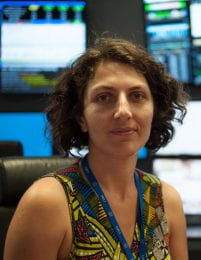
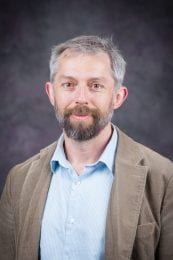
High energy physicists Keti Kaadze and Yuri Maravin spent their sabbatical leaves with K-State’s entire High Energy Physics CMS group except Prof. Andrew Ivanov at the Center for Nuclear Research (CERN) in 2023. While a sabbatical offers an important opportunity for faculty to increase their focus on research, this was especially crucial in the post-COVID period as the CMS experiment recovers from implications due to the pandemic. The sabbatical afforded Yurii and Keti a unique opportunity to make a significant impact on the ongoing operations of the CMS detector in addition to making excellent progress in K-State’s own research program.
While there, Keti and Yurii mentored graduate student, James Natoli, as he worked on the hadron calorimeter (HCAL), a subsystem of the CMS detector. James acted as the detector-on-call-expert supporting daily operations of the HCAL and addressing questions during the data-taking process. He was also responsible for deriving calibration constants of some of the HCAL components which improved the quality of collected data for the analyses.
Natoli returned to the K-State campus from CERN in December after making significant progress in the search for an ultra-rare decay of the W boson into a triplet of pions, which is the thesis topic he intends to defend at the end of summer.
Keti also worked with postdoc Dennis Roy who was appointed coordinator of the HCAL operations team last year. As coordinator Roy monitors, reviews, and plans activities to ensure that detector operations run smoothly. With Kaadze’s guidance he also became engaged in searching for a three Higgs boson production in collaboration with researchers from Brown and Peking Universities and the Rudjer Boskovic Institute, with several other groups, for the first time at the LHC.

Maravin and GRA Braden Almond and postdoc Giulia Sorrentino completed the necessary integration of the K-State concentrator card for the Mip Timing Layer Detector (MTD), an upgrade of the CMS detector that will go online in 2026. Yurii served as the US CMS manager of this project to design, produce, and test the concentrator card, one of the final steps needed to proceed with production and testing in 2024.
Given the success of the integration activities of the MTD readout unit designed and built by the K-State Electronic Design Laboratory, postdoc Sorrentino was elected to lead the data acquisition activities for the entire MTD project, further increasing the impact and visibility of the K-State group on the international high energy physics scene.
Allmond is continuing his work at CERN and will return this summer to begin writing his dissertation.
One of Kaadze and Maravin’s most rewarding aspects at CERN was spent serving as guides at CERN where they met many visitors and led them on tours of the CMS experiment site and delivered lectures about particle physics research to groups of high school students.
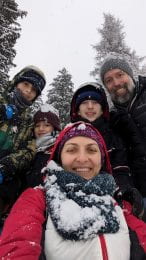
Spending their sabbatical in Europe also brought great opportunities to the K-State group. In addition to enjoying hiking and skiing in the areas near the Alps, they enjoyed traveling to historic sites and engaging in various local activities. A highlight of Keti and Yurii’s was a trip to the Normandy region of France, where they visited historic sites of the Normandy landings on June 6, 1944. It was gratifying for them to notice that the French still express gratitude for the sacrifices made by the Allied Forces in those in these battles.
The sabbatical leave for Keti, Yurii, and their group was a resounding success as they achieved several professional milestones in hardware, data analysis, and operations projects. In addition they were able to strengthen current collaborations and establish new ones for their future research and take advantage of travel opportunities while living in Europe.
Nobel Prize Connections
The joint winners of the 2023 Nobel Prize in Physics were Pierre Agostini, The Ohio State University; Ferenc Krausz, Max Planck Institute of Quantum Optics; and Anne L’Huillier, Lund University. They were awarded the prize “for experimental methods that generate attosecond pulses of light for the study of electron dynamics in matter.” They were recognized for experiments that have demonstrated ways to create extremely short pulses of light that can be used to measure the rapid processes in which electrons move or change energy. All of them have been on the K-State campus over the years to present their research.
Agostini delivered a physics colloquium at K-State in 2005; and L’Huillier and Krausz attended the 2nd International Conference on Attosecond Physics in Manhattan in 2009. K-State was selected to host that conference in part because of the research that was going on in the J.R. Macdonald Lab (JRML), whose members Zenghu Chang (now at the University of Central Florida), Lew Cocke (professor emeritus), and Chii-Dong Lin (still active) made important early contributions to the field of attosecond science.
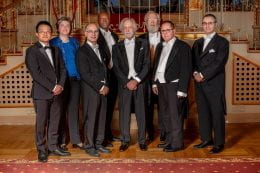
Over the years, JRML faculty played an important role in this field and have been working with this year’s Nobel prize winners, publishing papers with all of them. In particular, Cosmin Blaga, assistant professor here at K-State, is a long-time collaborator of Pierre Agostini. Agostini was Blaga’s Phd advisor at The Ohio State University. Their ongoing collaboration has spanned two decades and resulted in 23 joint publications to date. Blaga was in attendance at the Nobel ceremony in Stockholm in December.
The main goal of attosecond physics is to understand and ultimately control light-matter interactions at timescales commensurable with electronic motion in atoms, molecules and assembles of molecules. These fundamental processes play a critical role in chemistry and biology, as they are responsible for photosynthesis, energy flow inside and between cells, vision, cell replication, etc. The atomic, molecular and optical physics researchers here at K-State undoubtedly will continue contributing to this important field of research, seeing how they too can continue making their mark on the future of physics.
Attosecond science at K-State will receive a new boost with the arrival of new faculty hire Meng Han whose main area of expertise is generation, characterization and applications of attosecond light pulses.
In Memoriam: Bruce Shore

Bruce Shore, associate professor here in physics at K-State in the 1960s, passed away in January of 2023. Bruce moved on to Lawrence Livermore National Laboratory where he stayed until his retirement in 2001. Shore was co-author of the well-known ‘Principles of Atomic Spectra’ with Donald H. Menzel. A special issue on coherent control that Journal of Physics B: Atomic, Molecular and Optical Physics was published in honor of his life and work. It can be found here.
Staff News & Honors
Math/physics accounting specialist Cindy Carlyon celebrated 5 years of service at K-State and in the department in addition to being acknowledged with a meritorious service award. This award recognizes individuals who have demonstrated extraordinary effort in their position which has proven to be a valuable service to the K-State community. Cindy definitely is deserving of this honor.
High energy physics research associate Brigid Crowe was a recipient of an award from the Universities Research Association Visiting Scholars Program to facilitate her work on the mu2e experiment at Fermilab.
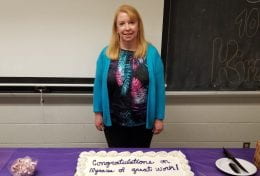
The department celebrated accountant Kim Elliott’s 10 years of service on campus with all 10 of these years in the department. Kim started at the receptionist position prior to being appointed accountant a few years ago. In addition to being recognized at the university ceremony, the department celebrated Kim’s milestone achievement at a reception in the department.
Undergraduate advisor Janae Mooty was recipient of the College of Arts & Sciences 2023 William L. Stamey Advising award. Janae advises not only for physics but for biochemistry and molecular biophysics and statistics as well. Michal Zolkiewski, Tim Bolton, and Perla Reyes, heads of these departments said of Mooty, “With solid preparation in STEM research and teaching, Janae is committed to student success in academia. She [is clearly] interested in building high-quality academic advising collegewide and shares her experience with other advisors. Her advisees appreciate her dedication, caring, and approachable style, and knowledge of academic regulations. Janae is an outstanding advisor, genuinely committed to helping students achieve their goals.” Mooty and other college award recipients were recognized at a celebration in February.
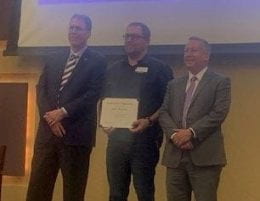
Andy Thurlow, machinist, was recognized as the University Support Staff of the Year awardee in the technical and professional category in the spring of 2023. Thurlow manages the department’s machine shop in which he designs and builds state-of-the-art equipment to further the research efforts within the department and across the campus.
Accounting Specialist Balances Work and Play
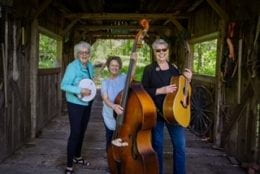
Cindy Carlyon, accounting specialist for math and physics doesn’t just excel in the office. She has been counting the beats and displaying her musical talents throughout the great state of Kansas as a member of a musical trio, “The Church Ladies.”
After hours and on the weekends, Cindy can be found singing and playing melodica and bass (which is bigger than she is!) with her talented counterparts Mary Louise Stahl and Joan Nelson. These church ladies are definitely not performing a bunch of old hymns on the pipe organ but instead are wowing crowds at their shows with harmony-based acoustic performances of country, classic rock, bluegrass, and folk music. You can read more about Cindy and her group and find a schedule of their upcoming shows at www.churchladiesks.com/.
Contact Us: We Want to Know What You’ve Been Up To
We want to hear from you! Please contact us at alumni@phys.ksu.edu or give us a call at 785-532-6786 to let us know how you are doing. If you find yourself in the Little Apple, let us show you around the department so that you can connect with our current students, faculty, and staff who will bring you up to speed on the latest happenings in the department.
Don’t forget to send us your news for inclusion in an upcoming newsletter.
Support K-State Physics: Please Consider Giving Back
The Department of Physics has many alumni and friends with successful careers in academia and industry. You all play an increasingly important role in supporting the department’s initiatives in areas that make significant contributions to our society.
There are many ways you can help to make our programs even better …
- Help us recruit! You know what it takes to succeed in our program, so help us find students who will excel in the classroom and research labs. Recruiting for our undergraduate and graduate programs is a high priority, so if you are in academics or working with student and interns in industry, please let them know about the exciting opportunities here in Physics at K-State.
- Invest time! Time is a generous offering that benefits our students. Interested in mentoring students? Want to host a student for a job shadowing experience? Have an internship or job position available? Contact the department at alumni@phys.ksu.edu or call (785) 532-6786.
- Make a gift! We welcome your support in the form of a gift to either a directed fund or a general gift to the department. If you wish to direct a gift to the department, please contact the K-State Foundation Arts & Sciences Development team who will match you to programs that connect with your interests and passions. They can be reached at (800) 432-1578. You can also make a gift online by visiting the K-State Foundation.
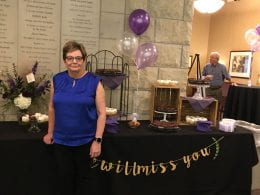


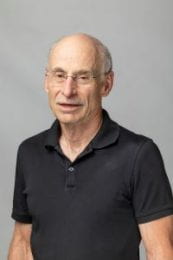
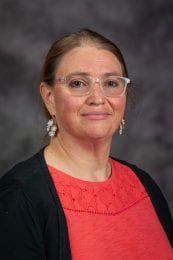
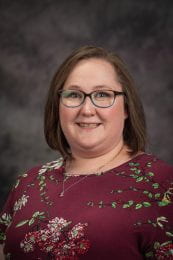
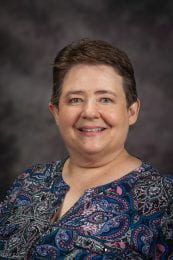

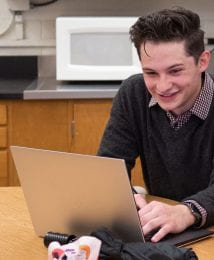
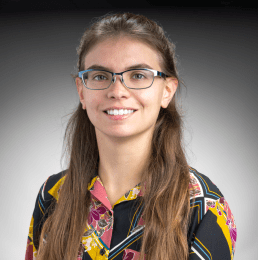
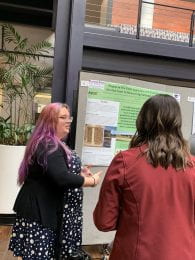
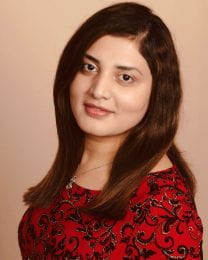
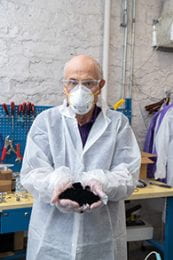
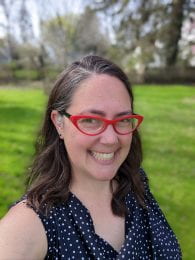
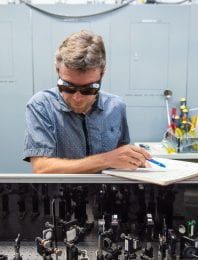
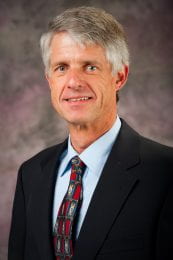
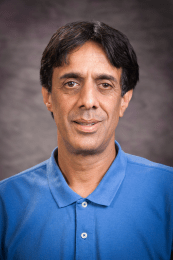 Bharat Ratra, university distinguished professor of physics has been named a 2023 fellow of the American Astronomical Society.
Bharat Ratra, university distinguished professor of physics has been named a 2023 fellow of the American Astronomical Society.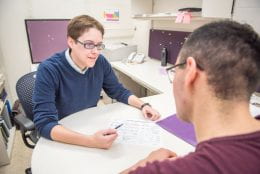
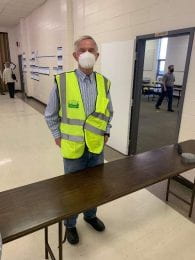
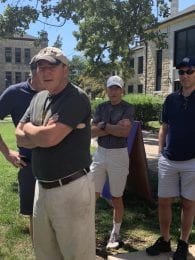

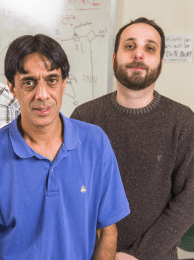
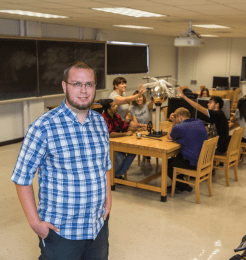
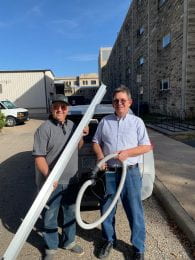
 Alharbi, Hessah — MS 2021, Advisor: Chris Sorensen
Alharbi, Hessah — MS 2021, Advisor: Chris Sorensen